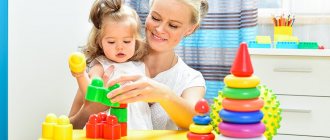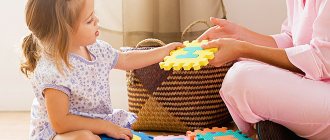Every child from birth has an individual temperament, which determines the child’s behavior in the early stages of development. It is advisable to begin educational activities from the moment the child realizes his personality. The psychology of raising a 2-3 year old child includes advice that contributes to the versatile and harmonious development of the individual. Based on the behavior of a 2-3 year old child, it is too early to judge what his character will be like as an adult. He is just learning to manage himself, and his parents should help him with this.
Psychology of a child at 2 years old
The phenomenon of the two-year crisis is familiar to many parents of babies. Sometimes a child at this age literally transforms, begins to be stubborn at every step and show disobedience. With childish tenacity, he rejects any demands and, with the help of protest, asserts his “I”.
The psychology of a child at 2 years old, both girls and boys, undergoes significant changes. At this time, the baby begins to realize his individuality, he learns to manage his body and control natural functions. He understands that he is not one with his mother, but is an autonomous person.
To emphasize his independence, the baby resists any requests and in every possible way resists the pressure of his parents. Only by opposing himself to adults does he embark on the path of individualization. Parents simply need to survive this period, since without it further formation is impossible.
Features of the psychological development of a 2-year-old child:
- The baby learns to imitate. A parent or teacher is a standard for him.
- Speech develops quickly and vocabulary expands. The baby can perform complex actions at the request of the parent. He tries to understand what adults are talking about and take part in the conversation.
- He is not yet very interested in his peers. His favorite activity is studying objects, and at this stage it is necessary to help the child study their properties.
- The baby begins to master generally accepted norms of behavior.
- He is not able to plan his actions and actions. The child acts spontaneously, under the influence of an impulse.
- The baby explores his body and its properties in various positions and begins to use facial expressions.
The baby tries to control himself physically and psychologically (sits on the potty on his own, refuses to fulfill requests, runs away from the adult during a walk). At 2 years old, a sense of autonomy appears in the child’s psychology, which needs reinforcement.
Adults need to be patient and flexible. There is no need to try to break the child’s stubbornness, but you also cannot give in endlessly; there is a risk of raising a domestic tyrant. It is better to distract the baby, switch his attention to something interesting and fun. This will help avoid confrontation. It is necessary to praise the child for every achievement, stimulate his creativity and imagination. He must feel that his opinion is respected and that he is taken into account as an adult. But in matters related to the health and safety of the baby, you should be firm. He will quickly learn that in some cases it is useless to persist.
Is your child three years old? Be patient
Understanding oneself as part of the world does not go smoothly for a child, and this is quite normal. Realizing that he is also a person, the baby tries to understand what he can do in this world and how he should act in each individual case. And these tests begin with testing the strength of the parents. After all, if they tell you what needs to be done, why shouldn’t he, the most important person in the family, give orders? What if they listen! He begins to change, his worldview and habits change. At this time, parents notice that their baby is no longer only listening and crying, but is already commanding them, demanding this or that object. This period is called the three-year crisis. What to do? How to cope with your most beloved little person and not offend him? Features of raising children 3-4 years old directly depend on age-related developmental characteristics.
Features of behavior and psychology of a child 2–3 years of age
There is no talk at all about the correct behavior of a child until he reaches 3 years old. At this time, his actions are dictated by the characteristics of his temperament. The child may behave unpredictably, changing his preferences many times during the day.
The psychology of children from 2 to 3 years old has its own characteristics:
- A craving for new activities awakens. At this moment, it is important to provide the opportunity to master them.
- Kids make leaps in mental development. Exercises should be aimed at developing motor skills; appliques, modeling, and lacing are suitable. These types of activities improve imaginative thinking and memory.
The psychology and development of a 2.5 year old child is characterized by the emergence of independent activities and the formation of imagination. There is no need to overload your baby with developmental exercises; it is useful for him to play with toys. It is advisable to purchase several dolls, cubes, animals and construction sets. At the age of two, a child builds intricate structures from toys. He feeds and puts dolls and animals to sleep. At the same time, the baby speaks on behalf of each of the characters. These are normal psychological characteristics of the behavior of children 2–3 years old.
To develop a preschooler’s memory, you need to read poetry to him. If the child is able to easily remember short poems, then you can try to learn other information (names and surnames of relatives, address, age). It is advisable to read fairy tales and poems every day, it helps develop speech. Fairy tales by Pushkin, poems by Barto, Chukovsky and Marshak are suitable. At 2–3 years old, children learn new languages well; this time should be used to study them, especially if the child’s parents are of different nationalities.
The psychology of children 2–3 years old is such that difficulties often arise with their emotional state. The kid finds out the limits of his influence through protest. At this age, the child strives to do everything on his own. To prevent this desire from disappearing, you need to allow him simple actions that he can master.
Strict prohibitions often lead to hysterics and aggression. Therefore, the psychology of raising children under 3 years old includes presenting information in the form of a game. This will relieve tension and prevent a fit of hysteria. At this age, the first manifestations of anxiety are possible.
If at this age psychological trauma was sustained due to stress, fear, fright, in the future the person will need psychological help, which should be provided by a specialist, for example, psychologist-hypnologist Nikita Valerievich Baturin.
Physiology of age
The rate of brain growth decreases, but still remains high. Connections between the hemispheres have strengthened, stimulating the interaction of creative and rational perception. Despite the almost completely completed process of brain development, inhibitory functions are practically absent, giving way to excitation. Because of this, the child often puts himself in danger when exploring the world around him; he cannot sit still and focus on one object for a long time.
The optimal height of a three-year-old child is 92 centimeters and weight is 15-16 kilograms. The head circumference is 47-48 centimeters, the chest circumference is 52.5 centimeters. Arms and legs grow faster than the body, which leads to a change in its proportions. Due to this, the center of gravity shifts, and the child begins to walk better and faster. Muscle mass is gained quickly; the average weight of a 3-year-old child is 15 kilograms.
A child's age of 3 years indicates good color vision. But the eyes are a very sensitive organ, so you should avoid unfavorable factors: watching TV or computer for a long time, poor lighting. Otherwise, it may lead to visual defects. The hearing organs are fully formed, but you need to be careful, since otitis media is very common at this age, which leads to hearing loss.
The strengthening of cartilage tissue, which predominates in the skeleton of a 3-year-old child, begins to occur. Due to the fact that he cannot sit in one place for a long time, bone deformation does not occur, which can be expressed in incorrect posture, stooping, and curvature of the arms and legs. The child is already trying to draw, but it is not easy for him. Since the muscles of the shoulder and forearm develop at this age, the child does not hold a pen or pencil well with still unformed arm muscles. Therefore, such activities do not last long - the baby gets tired, which is completely normal for this age.
The child’s cardiovascular system is stabilized. But his blood pressure is much lower than that of an adult, since the vessels are not yet very elastic and flexible, and the vascular bed is very wide. There is an intensive development of the immunological apparatus. Despite the rapid development, the child may often get sick, the most common being an allergic reaction.
Metabolism is very fast, since the body needs to develop, and the child spends a lot of energy per day. Therefore, it is necessary to monitor your diet and prepare balanced meals. The most intensive development of the pancreas occurs.
The speech apparatus and vocabulary also develop rapidly. Along with great curiosity, this leads to constant conversations, and the baby can often talk to himself, especially during play. The child already knows how to separate himself from others, so “I” or his own name often slips into his speech.
Development of speech and articulation skills
At two years old, a child understands a lot and often speaks well; his vocabulary quickly expands. You need to talk to your baby as often as possible. It has been noticed that children with silent parents master speech much later. Phrases should be concise, but at the same time emotionally charged. You cannot distort words when talking to a child.
Children who have sisters and brothers speak well already at the age of 2 years. They express themselves in simple phrases about what is interesting to the baby. Older children use actions and commands in their games that require execution. This helps develop speech skills. This is not the case in games with peers.
In the games of two-year-old children, an adult or older child should participate, who initiates joint actions (for example, preparing Easter cakes, building a house). This will help kids act collectively, compete and interact through speech.
A manual on child psychology for parents of 2-3 year old children recommends:
- play games with imitation sounds. Kids love it and at the same time develop articulation skills;
- look at books and invite him to complete simple phrases himself;
- pronounce or sing complex words;
- study the properties of objects, for example, soft toys (color, size, temperature, etc.);
- learn tongue twisters and songs.
Parents play an important role in the development of a child's speech. Much depends on their efforts and patience. But you shouldn’t harass your child with continuous activities and comments. The development of speech should be carried out in the form of a game and end at the moment when the preschooler loses interest and his attention is scattered.
Raising a child up to one year old. Problem children
Many parents like to compare their children with others. They watch how quickly new skills appear in the neighboring children or in their own, and compare characters. And some parents discover that their child is difficult.
I once read in one book that there are no difficult children. There are children with increased needs. Agree, I don’t really want to admit that my beloved baby is restless, capricious or difficult. But when it comes to the increased needs of the child, the situation takes a different turn. It turns out that each child has his own level of needs. It may be elevated in some children. Such children require constant attention from their parents and react nervously to changes in the environment or the appearance of new people in their environment. They cannot calm down or fall asleep on their own and are very energetic. At the same time, parents never know what to expect from them and are always looking for new ways to calm and entertain. And this does not mean at all that you need to fight them and try to make them “normal”.
Moreover, it is believed that a child who “bathes” in the attention of his parents in childhood (and what else can parents do) grows up more self-confident, knows what he wants from life, and knows how to achieve his goals.
Communication with such a child is a valuable experience for his parents. They learn to satisfy the needs of their child in different ways, and get used to life in close contact with the baby. The most important thing is to remember that you need to enjoy communicating with your child and not take everything to heart. Over time, when the child becomes more independent, parents will even miss the close connection to which they are accustomed.
Psychology of boys and girls before and after 2 years of difference
At the beginning of the 3rd year of life, babies begin to realize that they belong to one of the sexes. Until 2 years of age, there is no gender self-identification. Awareness comes earlier if the child attends a children's group. It can be noted by dividing children into groups to play together.
Features of the psychology of a child 2–3 years old, boys:
- do not like repetition in learning;
- perceive information more visually than auditorily. Therefore, it is better to show them than to tell them;
- Despite popular belief, boys are sometimes more emotional than girls. There is no need to forbid them to cry if there is a good reason for this;
- Boys use their distant vision more, so they need a lot of space for entertainment. They love active activities (catching up, fighting, playing with a ball);
- love toys that involve transformation and movement: cars, construction sets, cubes, etc.;
- they strive to compete, to stand out, this desire can be redirected to sporting events.
Boys need to be taught respect for girls from an early age. Explain that fighting with them is unacceptable. Talk about the role of a man in the family as a protector and head. It is better for the father to do this and demonstrate by example how he treats women in the family.
Differences in the psychology of a 2–3 year old child, girls:
- knowledge is better perceived step by step, they like repetition and consolidation;
- information is mainly perceived in audio form, so it is better not to show it to them, but to explain it to them;
- girls are partial to bright and beautiful things. For games, dolls and soft toys are suitable for them, with which they can act out scenes;
- they are sensitive to affection and need more affection than boys.
For girls 2–3 years old, you can purchase sets of dishes, furniture and household appliances so that they can play housewife. They strive to imitate their mothers and love to help with housework. This will help develop their desire to take care of someone and show maternal feelings.
Mental development of children at 3-4 years old
The age of 3-4 years is very important for the development of a child’s psyche.
It is now that the foundation of his personality is laid and moral concepts are formed.
Also, this age period is marked by a crisis of 3 years. Its main result is the child’s self-awareness, separation of himself from his parents.
There is a significant leap in the development of the organism as a whole.
A three-year-old child is already so well developed that he can control his body and do several actions at the same time. And the skills that he masters during this period will remain with him for the rest of his life.
Now his gross and fine motor skills are developing well. He continues to actively study the world around him, is interested in phenomena, names, purposes of objects, etc.
At 3 years old, children really like to be active. Their coordination, endurance, flexibility, and agility develop.
In general, a three-year-old child is in high spirits and eager to explore the world.
Intellectual sphere
The child's intelligence is actively improving.
At 3-4 years old, a child knows by heart excerpts from his favorite works.
He actively forms ideas about objects and their details. The child learns to depict them using drawing or modeling. The craft or drawing may still be missing some details - this is normal. The child begins to use different colors when coloring.
At 3-4 years old, children normally already understand what gender they and the people around them belong to.
Attention
At this age, attention is still involuntary.
It is difficult for children to keep their attention on one subject. Often they switch to something new - something that interests them right now.
On average, a child is able to maintain attention for no more than 10-15 minutes.
But, if he gets carried away with the game, he may not be distracted for half an hour, or even an hour.
Memory
Memory is now also involuntary, like many other mental cognitive processes.
The child, in general, remembers well and for a long time what interested him, surprised him, or even frightened him.
Three-year-old children recognize objects well, but they cannot yet remember them purposefully.
Thinking
At 3-4 years old, a child may still be dominated by visual-effective thinking. Some children need a specific object in order to perform actions with it. This does not mean developmental delay at all. This option is a feature of the nervous system that does not require correction.
At the same time, in 3-4 years, visual-figurative thinking is very actively formed. The child increasingly tries not to tie his actions to a specific object. He learns to transfer them to an imaginary situation - for example, to play pretend.
Also, three-year-old children are able to analyze, compare, find differences and draw simple conclusions.
They already understand general words (vegetables, fruits, dishes, clothes, animals, birds, etc.)
Perception
At 3-4 years old, children are able to distinguish:
- 7 or more colors;
- 5 or more forms;
- objects by size, weight, location in space;
- people's emotions;
- temporal concepts (late, later, now, tomorrow).
Imagination
Three-year-old children can already recreate in their imagination images from fairy tales and adult stories.
They often mix the fabulous and the real. Moreover, the invented images are so rich that children seriously believe in their reality.
In their games at 3-4 years old, children try to play with substitute objects. For example, they can “cook” soup in a bucket of pebbles and sand.
The development of imagination is well promoted by reading fairy tales and visiting new interesting places and events.
Speech sphere
At 3-4 years of age, speech continues to actively develop.
The child becomes interested in the meaning of unfamiliar words and expands his vocabulary.
He already speaks well in whole phrases, expressing his desires, feelings and thoughts. The child correctly uses nouns with prepositions and agrees them with adjectives in number, gender and case.
A three-year-old knows and says his name and age; uses words such as: “thank you”, “please”, “hello”, “goodbye”.
Children at this age like to repeat by heart poems and verses of songs, and short excerpts from fairy tales after adults.
They understand short stories without relying on pictures. And from the pictures they can tell what is shown on them.
Children 3-4 years old recognize excerpts from familiar works.
They can dramatize a fairy tale using dolls or figurines.
Emotional-volitional sphere
The child becomes purposeful and persistent
In general, the child is in high spirits. He is active and inquisitive.
But during this age period, mood swings often occur.
Emotions depend on the child’s physical condition and the degree of his comfort. Changes also occur during an age crisis.
A three-year-old child becomes purposeful and persistent, and also, at times, stubborn and tyrannical.
Play activity
Play is the main activity at this age.
Children play simple role-playing games with substitute objects.
At first, it may be necessary for an adult to show and teach how to “replace” a game object.
Also, children aged 3-4 years like to play with older children. They begin to learn to play by the rules.
Children at this age usually have favorite toys and games.
Games and toys for children 3-4 years old
A 3-4 year old child needs toys that will help him develop speech, as well as physical, mental and creative abilities.
In general, it is worth choosing the following toys:
- for active recreation: scooters, skittles, jump ropes, balls, dance mats, etc.;
- for hearing development: musical instruments, interactive books, talking toys;
- for relaxing games: puzzles, lotto, mosaic, lacing;
- for creativity: paints, easels, pencils, plasticine, colored paper, children's scissors, etc.;
- for role-playing games: toy furniture, a set of a doctor or a policeman, a car you can sit in, etc.;
- for boys: a set of tools, soldiers, robots, radio-controlled toys;
- for girls: dolls, children's kitchen or hairdresser, strollers, dishes;
- for the development of intelligence: board and printed games such as: “Collect the figures”, “Where is whose house?”, “Compare”, “Where is the half?” etc.
Communication sphere
A three-year-old child likes to communicate with others. Most often this happens at the level of instructions from an adult (ask, offer, etc.).
Children enjoy playing with their peers. They need this, rather, to show off themselves and their toys, and to have a partner in the game. For example, then, to run away from him or crawl towards him, etc.
At the same time, the guys often quarrel over toys.
Tasks for children who have not yet mastered speech
A 2-year-old child does not always know how to speak. This should not be a cause for concern if he understands when he is being addressed, fulfills his parents’ requests, and looks straight into the eyes during communication. He will definitely talk over time. We need to talk to him more, read books, sing songs to him. It is also important for intellectual development to use fine motor skills.
The formation of speech depends partly on the physical development of the baby. In addition to fine motor skills activities, he should be allowed outdoor games (riding a bicycle, climbing on sports equipment, stairs). It is useful to purchase a sorter toy with at least 4 different shapes. During the game, you need to name the geometric shape and feel the boundaries of the contour with your fingers. Place into the appropriate hole.
The boy cannot be limited in pouring water and pouring any objects from one form to another. You just need to first create a platform that is easier to clean. You can make appliques, cut out, sculpt balls and sausages from plasticine, and draw shapes. All these actions are beneficial for the baby's development.
We speak, we think, we understand, we think
The memory of a preschooler aged 3–4 years is involuntary. He easily remembers things or events that have a strong emotional or sensory overtones, and remembers them for a long time. The same applies to attention: you can attract and retain it with something interesting that evokes vivid emotions. Thinking at this age is visual and effective: the child understands and carries out much better what was shown to him visually, rather than explained in the form of verbal instructions.
The perception of a child of this age is still objective. The properties of an object (color, size, smell, taste) are not shared with the object itself. Often, a child identifies an object by one or two of the most significant features: the sky is blue, the orange is orange and sweet. The child is now very observant. He can pay attention even to little things that an adult did not notice.
The speech of a child in the fourth year of life has stepped far forward in its development:
- vocabulary can exceed 2000 words;
- in the baby’s active vocabulary, verbs and adjectives, rather than nouns, now predominate;
- proposals become common;
- complex speech structures appear;
- The child’s games and activities are accompanied by “talking to himself,” which allows him to keep in mind the ultimate goal of his activity, as well as “delegate” some actions to his speech so as not to perform them in reality.
The development of speech is facilitated by the growth of cognitive and mental activity, in particular those aimed at studying the world around us. The world around him seems extremely interesting to the baby, he pays attention, analyzes what he hears, and clarifies the details.
A child in his fourth year of life already knows:
- general terms (animals, birds, plants, toys, dishes);
- time division of the day (morning, afternoon, evening, night);
- seasons and natural phenomena that correspond to them;
- names of domestic and wild animals, the difference between them;
- names of birds, fish, insects;
- dividing plants into trees and (for now) flowers, knows their names;
- the difference between vegetables, fruits, berries, mushrooms, knows their names;
- many materials from which the objects around him are made;
- the difference between living and non-living;
- the difference between what is made by man and what exists in nature.
Such a leap in general development inevitably entails an increase in mental and logical abilities. By the age of four, a child is able to comprehend a chain of actions, understand that one action leads to another (although sometimes he still confuses cause and effect), and can think through a simple sequence of actions to achieve a specific goal.
A preschooler of this age can already:
- fold a picture consisting of 4 parts;
- find a discrepancy with reality in the picture and explain it;
- find an extra item from several and explain why he decided so;
- find similarities and differences between objects;
- complete the task for about 10 minutes without distractions;
- find pairs of objects;
- find an item by description;
- assemble a matryoshka from 6 units;
- lower the figures into the slots in accordance with their shape;
- perform the actions shown by the adult;
- count to three (and even to five), bending your fingers to count;
- name and show the basic geometric shapes and colors of the rainbow;
- compare objects by color, size, shape;
- find a pair for an object with the specified characteristic;
- remember the letters of the alphabet (but cannot yet put them into syllables).
Moral education
At the age of 3 years, it is already possible to instill in children a love for their native places and develop citizenship. You should start with the development of self-respect, nobility in relation to others in everyday life, and the study of national culture. If you present it in an interesting way, children will quickly learn everything. The easiest way to instill patriotic education is through animation. There are many cartoons, both modern and Soviet, that convey noble and strong images of knights, Russian heroes, as well as brave women prone to self-sacrifice.
Psychology: we measure to our own yardstick
The child's psyche from 1 year to school goes through a complex and intense stage of development: speech, memory, thinking, perception, character formation are associated with inevitable periods of crisis, for which adults need to be prepared.
During the crisis period of 3 years, the child’s psychology undergoes radical changes. The emotional state of children of this age is extremely unstable. Children are easily excitable, fussy, and have frequent mood swings, attacks of aggression or apathy.
At this age, babies are characterized by:
- emotionality;
- responsiveness;
- empathy for others;
- desire to help;
- friendliness;
- feeling of shame for a bad deed;
- high need for communication with peers.
In terms of mental development, children 3-4 years old are strikingly different from those who are only a year younger.
- Now they are already able to understand that the “sphere of my self” exists not only for them, but also for other children. Therefore, in games, children are able to value not only their “territory”, but also the personal space of those with whom they play, and are able to take into account the interests of the surrounding community. But conflicts cannot be avoided, because one’s “I” is considered more important.
- The games themselves gradually become role-playing; the child learns to interact with other children (for now, as a rule, they are the same age), based on imitation of their parents. The first rules appear in games.
- There is an understanding of oneself as a person of a particular gender (I am a girl, I am a boy). Children begin to recognize their peers externally by their gender (clothing, hairstyle, jewelry), and show a keen interest in children of the opposite sex.
- The child is aware of the social roles of the people around him (this woman is a teacher, mom is also a woman, she is a librarian, dad is a man, he is an engineer) and understands the difference between social and family roles.
Mental immaturity and a huge amount of new information, new rules and norms that a child has to master from 3 to 4 years old lead to inevitable difficulties. Sometimes it is difficult for a child to cope with the situation. Not having the skill to manage emotions at the proper level, he tries to overcome circumstances by available means:
- attracts the attention of adults by screaming and crying;
- tries to take revenge on the offenders;
- strives to do everything in defiance - not just himself, but in his own way, even if he hears reasonable arguments from adults;
- tries to achieve his goal by cunning (which adults often see through, which makes the baby even more angry);
- demonstratively violates the boundaries of what is permitted, even if he clearly knows them;
- begins to manipulate his elders, suddenly turning from a “jack of all trades” into a complete “incompetent.”
The desire to violate the ban is especially strong. The child sees this as a manifestation of adulthood, and not just independence.
Advice from a psychologist to parents on raising a 2-3 year old child
Until the child reaches the age of 2–2.5 years, there is no point in punishing him. He does not yet feel like he is the culprit of the incident. He sees the result of his actions, but does not associate it with himself in any way, and does not realize how it happened. The only thing he will take away from punishment or reproach is that he is bad and is not loved.
Until a certain time, we must refrain from angry tirades and detailed explanations of what not to do. The baby still cannot understand them. At this stage, clear and reasonable restrictions and prohibitions are sufficient.
From about 2.5 years old, the child begins to feel like an independent person, and he is already able to understand who is to blame for the incident. He realizes that some actions are good and make loved ones happy, while others are bad. But he is still learning to control himself, and from time to time he will continue to act contrary.
Often at this age, children have imaginary friends to whom they shift responsibility for bad deeds. This allows the child not to feel guilty about the wrongdoing. It is important to understand the motives for his behavior. To do this, you need to discuss the incident with your child and help correct the situation. This must be done in a calm, friendly tone, then he will not be afraid of punishment and will willingly explain what motivated him.
At the age of three, children often behave badly, defining the boundaries of what is permitted and acting to spite their parents. This gives them a sense of adulthood and independence. If you punish for misdeeds, then instead of obedience the baby will show resistance. It is important to be patient at this stage; over time, the relationship with the baby will improve.
Difficulties in education
Drastic changes in character
Parents are often shocked when their baby, who has been so obedient until now, suddenly begins to behave in a sharply negative manner. Tastes change, and those toys and activities that were previously liked become unloved, the little rebel contradicts his elders, sometimes as if he does it on purpose out of spite, or it’s the other way around. For example, he doesn’t go for a walk, even if he wants to. He gets angry, capricious, and sometimes behaves badly in public.
Hysteria, manipulation
Probably everyone has seen a similar scene: a toddler falls on the floor in a shopping center and begins to scream loudly, demand to buy something, and is hysterical. Parents are often lost, and if those around them also insert judgmental remarks, then an unbearable feeling of shame forces them to follow the child’s lead. This behavior can take hold: a 3-4-year-old baby becomes a manipulator who twists his family as he wants, feeling his impunity and power.
Suppression of natural activity
But there is another extreme: when the father and mother “defeated” their offspring, he becomes quiet, obedient, fearful and completely lacking initiative. Any natural manifestation is followed by an angry shout: “Where did you go?” "Don't run!" "Do not touch!" In the end, the baby stops trying to do something and decides that it is better to sit quietly and not poke his head out. After all, he really needs his mother’s and father’s love, and being bad in the eyes of his family, he will not be able to get it. This is how learned helplessness is formed.
Mom and Dad can't agree
Contradictory upbringing during this period, for example, the combination of a controlling mother and a father who allows everything, has a negative impact on the formation of personality. The little person begins to understand that adults themselves do not know how to cope with him, and the rules of behavior are not the same for different people. Therefore, he adapts to seek protection from one of his relatives from the other. It often happens like this: the baby went to his grandparents, got “spoiled” there, then the parents just can’t teach him to be obedient again, and such educational “swings” are repeated time after time.
Fear of losing loved ones
It happens that a father and mother drag their son or daughter into their marital conflict and force them to take sides, which is extremely painful for the child, because they have to take on a responsibility that is beyond their strength for a small person. Such a child, out of fear of losing his mom or dad, tries to be good and fulfill all the requirements, but in fact he is in constant anxiety or, on the contrary, with his whims, deliberately bad behavior, unconsciously forces his family to rally around him.
You need to know that parental divorce at this age is extremely destructive for the child’s psyche. If the baby feels that his mother and father do not love each other, but stay together for his sake, he experiences an unconscious but deep feeling of guilt. Children at this age understand much more than is commonly thought, and any imbalance in the family system is reflected in the child’s behavior.
The main thing is the game
The main activity of preschoolers of this age is play. With the help of the game, the child hones communication skills, learns to respect his companions in the game, accept and comply with the rules established in it (and this already contributes to the acceptance of the rules of human society in general); masters new social roles, develops logical thinking, fine motor skills, comprehends the relationship between objects, actions and their results, and reveals his creative potential. In a playful way, parents can convey to the child the basic rules of behavior, etiquette, and explain what is good or bad.
By playing role-playing games with a child of this age, parents can understand what is happening in the soul of their child, since the baby certainly imparts all his experiences and problems to his character in the game.
Advice
If, during a crisis, your “great unwillingness” does not heed requests to help you with something, turn the situation into a game channel. Let your favorite bunny ask the child to help mom together: put away toys, take dishes to the kitchen, collect pencils, etc. The bunny can explain to the child that mom needs help because she gets tired, caring for everyone, and if she does something for her - she will become cheerful and grateful. Or, for example, the doll will ask you to clean the room in order to get to the chest of drawers in which the good fairy left a treat.
In a playful way, you can ask your child to help you:
- water the flower;
- wipe the dust on the shelf;
- put the shoes back in place;
- set the table;
- put a bowl of food for the cat;
- bring or serve something.
By the way, “occupational therapy” is the best way to make opposing sides allies.











